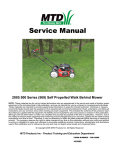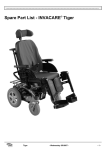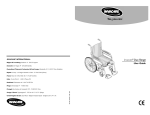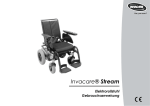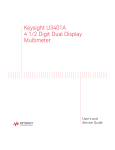Download Drive Motors
Transcript
13.0 Check and Repair Work on Drive Motors 13.1 General Drive motor, assembled Drive unit, assembled 8 1 5 2 1 6 3 9 1 2 3 4 5 6 7 Chassis Drive motor 2x Stopper for carbon brush 2x Coupling lever Motor plug Main module 2x Allen screw M6x30 with lock washer 8 Gear 9 Coupling mechanism 7 8 2 4 3 ✓ NOTE: Depending on type, the motors can be equipped with a coupling mechanism or with separate coupling levers. Inspection Remedy > Test motor, replace if necessary. > Test motor, replace if necessary. > Test brake, replace motor, if necessary. > Replace drive unit or gear. See chapter 11.6. Motor vibrating, emitting running noises? Motor wont start? Power brake not reacting? Gear emitting running noises or being blocked? 13.2 Testing or replacing carbon brushes ✓ NOTE: Worn-out carbon brushes lead to a deterioration of the motor performance. Each motor is equipped with two carbon brushes. They arelocated behind the lateral stoppers (4) of the motors. Removing carbon brushes Remove the stopper (4). NOTE: Make sure that, while you loosen the stopper, same is being subjected to a slight spring pressure. ✓ Pull carbon brush from its guide. 70 Removing carbon brushes Testing carbon brushes Testing length: Measure the length of the carbon brush. Orginal length = 13 mm. Wear limit = 11 mm Once the carbon brush has reached the wear limit of 11 mm, it must be replaced. Testing the bearing surface: Perform a visual inspection of the running surface. It must show only slight running traces. If the running surface shows deep grooves, the motor collector is damaged. Any further repair of the motor can only be performed by the INVACARE-Service Department. Installing carbon brushes Place carbon brush into its guide (see drawing). ✓ Wear Limit min. 11 mm Running Surface Installing Carbon Brushes NOTE: Make sure that the carbon brush is not canted when introduced. It must be able to move smoothly within the guide. Introduce the solder cap of the carbon brush into the guide as shown in the drawing. Screw in the stopper. ✓ Guide Carbon Brush Solder Cap Stopper NOTE: Do not fasten too tightly, it would destroy the stopper. 13.3 Testing motor, magnetic brake and free-wheel switch Testing preparations / replacing drive motors Remove battery boxes. Remove splash protection. Remove cable binders. Remove the connection plug of the motor to be tested or replaced from the socket board. ✓ Remove BUS plus Motor Cable Motor Cable NOTE: Press down plug lock as otherwise the plugs would be damaged. 71 Testing drive motors Only basic tests can be performed on the drive motors. Any further tests are only possible with special testing instruments. The following components of the drive motors can be tested by means of a multimeter: Motor coils for continuity Motor brakes for resistance Testing hints: If the following tests show no results, the drive motor should be sent in for testing. Any further measurements can only be performed by the INVACARE Service Department. Visual test of the plug contacts: Test whether the contacts of the plug are not unduly bent up, pushed back or oxidized. Plug Contacts Motor Brake Contacts Motor Contacts Testing the Electric Circuit of the Motor Testing the electric circuit of the motor Set multimeter to continuity check. Measure the continuity of the motors electric circuit at the plug contacts shown in the drawing to the right. ✓ NOTE: Instructions on the use of the multimeters can be found in the Users Manual. Testing the magnetic brake Engage the motors. Set the multimeter to resistance measuring. Measure the resistance of the brake coils at the plug contacts shown in the drawing to the right. It must amount to between 20 ohms and 200 ohms. Testing Magnetic Brake Testing the free-wheel switch: The free-wheel switch switches the motors to pushing operation, putting the magnetic brake out of function. Disengage motors. Set multimeter to resistance measuring. Measure the resistance of the brake coils at the plug contacts shown in the drawing to the right. The resistance measured must amount to infinite. Malfunction Cause No continuity of the electric circuit of the motor. Parted cable in the motor. Carbon brushes worn out. Resistance being 0 ohms. Resistance clearly > 200 ohms, but not infinite. Short circuit in magnetic brake. Defective contact in the magnetic brake. - 72 Resistance = 20 ohms - 200 ohms Solution Chapter Replace motor. Check / replace carbon brushes. Replace motor. 13.4 13.2 Replace motor. 15.4 13.4 13.4 Disasembly / Assembly of Drive Motor Disassembly of drive motor ✓ NOTE: The first two steps apply only to motors with a coupling Motor fastening Locking screw, M5 x 10 - SW 8 mm Disengaging Lever mechanism. Loosen locking screw (SW 8 mm) at the disengaging lever of the motor to be replaced. Remove the disengaging lever. Support drive motor with your hand, loosen completely two fastening screws (hexagon socket, SW 5 mm) with lock washers and detach drive motor. ✓ Fastening Screw, Hexagon Socket M6 x 30 - SW 5 mm NOTE: Do not damage / lose plastic bushing and starting damper. Assembly drive motor Push plastic bushing on the motor output shaft. Motor Output Shaft Plastic Bushing Place starting damper on the gear input shaft. Make sure that the driver of the starting damper interlocks with the gear input shaft. Gear Input Shaft Fasten the motor to the gear by means of the two fastening screws (hexagon socket SW 5mm) and the two lock washers. The following is to be observed: The motor cables must point upwards to the frame of the chassis. The slot of the motor output shaft must be in alignment with the driver of the starting damper. ✓ NOTE: If key and slot are not aligned exactly, turn the driving wheel (gear output shaft) until the slot locks into place and the motor is located exactly in front of the gear. Fasten screws hand-tight. Do not overturn. Starting Damper Driver 73 ✓ NOTE: The following two steps apply only to motors with a Position of Disengaging Lever coupling mechanism. ing lock Lock the motor by turning the shaft left by means of a suitable tool (e.g., a pipe wrench) = driving position. Now mount the disengaging lever and fasten it by tightening the locking screw (SW 8 mm). The locking screw (M 5 x 10) must contact exactly the flattened part of the shaft (see drawing). ✓ Disengaging Lever NOTE: Following the assembly, make sure that no moving parts such as rods or screw connections are sliding against the motor casing. Conduct a performance test. Lead the motor cable to the main module and plug the connection plug into the socket board. Locking Screw M5 x 10 - SW 8 mm Connection Plan: Motor Plug Batterie Battery linker Fahrmotor left driving motor M2 + + + ACS-Fahrpult rechter Fahrmotor ACS-Remote right driving motor 1 D X 2 M1 B U S 24V zu weiteren Modulen Secure the cables by means of cable binders Position of the Cable Binders Mount the splash protection. CAUTION: Following the assembly, the correct operating of the disengaging lever as well as the driving functions must be tested. >Make a test drive!< 74 Cable Binders





